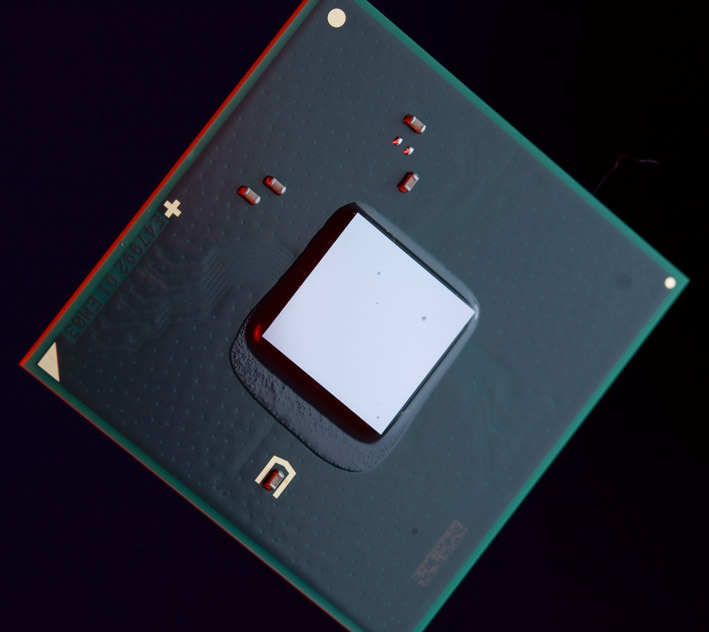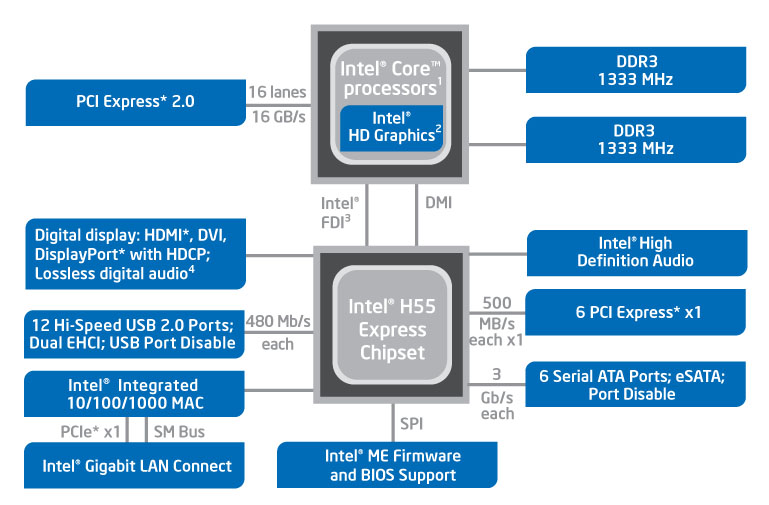Intel Core i5-661: Clarkdale Rings The Death Knell Of Core 2
H55 And H57 Chipsets
Connecting The Dots
As with Intel chipsets past, there’s a four-lane DMI pathway connecting the Clarkdale chips to component number two in Intel’s dual-chip platform. Capable of moving 1 GB/s in each direction, this should once again be plenty of bandwidth for the I/O not yet integrated onto the processor.
This time, however, there’s another interface between the CPU and PCH called the Intel Flexible Display Interface (FDI). Enabled by DisplayPort, this connection carries a display output from the processor package’s core to the connectors attached to H55/H57. The FDI consists of two separate links (one for each of the GPU’s display pipelines), and the unidirectional downstream pairs can be scaled depending on bandwidth requirements. This is why, while the core technically supports output resolutions up to 2560x1600, our Asus P7H57D-Evo only offers DVI output up to 1920x1200.
H55 And H57: Anti-Climactic Core Logic
With all of the integration that Intel is pushing, there’s actually very little left to talk about once we get into the chipset itself. You’re already familiar with P55—Intel’s first Platform Controller Hub, necessitated by a move to a two-component platform (and away from the processor/northbridge/southbridge configuration it once employed).
| Features | H57 | H55 | Q57 | P55 |
|---|---|---|---|---|
| Socket Support | LGA 1156 | LGA 1156 | LGA 1156 | LGA 1156 |
| HD Graphics with PAVP 1.5 | Yes | Yes | Yes | - |
| USB 2.0 | 14 | 12 | 14 | 14 |
| SATA Ports | 6 x SATA 3 Gb/s | 6 x SATA 3 Gb/s | 6 x SATA 3 Gb/s | 6 x SATA 3 Gb/s |
| PCI Express 2.0 Graphics | 1 x 16 | 1 x 16 | 1 x 16 | 1 x 16 or 2 x 8 |
| PCI Express 2.0 (2.5 GT/s) | 8 | 6 | 8 | 8 |
| Legacy PCI | 4 | 4 | 4 | 4 |
| Remote PC Assist for Consumers | Yes | Yes | - | - |
| Rapid Storage Technology | Yes | - | Yes | Yes |
| Anti-Theft Technology | - | - | Yes | - |
| Identity Protect Technology | Yes | Yes | - | - |
| Quiet System Technology | Yes | Yes | Yes | - |
| AMT 6.0 w/ Remote PC Assist for Business | - | - | Yes | - |
| ME Ignition Firmware | - | - | - | Yes |
| ME Firmware 6.0 | 8MB | 8MB | 8MB | - |
| SPI Device Size Required (in MB) | 8 | 8 | 8 | 2 |
There are actually three chipsets launching today, but we’ll keep our focus on the two most relevant to desktop users: H55 and H57. Q57 is more interesting to system builders working on business machines, since it enables Active Management Technology. Still, between these, you’ll find very few differences.
Let’s start at the top of our chart and work downward. As with P55, H55 and H57 are designed to complement LGA 1156 processors. Duh.
Get Tom's Hardware's best news and in-depth reviews, straight to your inbox.
H55 and H57 are differentiated in that they support Intel’s HD Graphics core with a protected audio and video path—needed to support HDCP and bitstream high-def audio. This PAVP 1.5, as it’s called in the chart, is a component of the management engine built into both chipsets. P55 doesn’t have it, which makes sense since it’s a discrete graphics-only platform.
Of course, you also get the I/O normally found in a southbridge. H55 offers 12 USB 2.0 ports, six SATA 3 Gb/s ports, and six lanes of 2.5 GT/s PCI Express 2.0, while H57 serves up 14 USB 2.0 ports, six SATA 3 Gb/s ports, and eight lanes of 2.5 GT/s PCI Express 2.0 connectivity. Both offer four legacy PCI slots, too.
From there, the two chipset are identical, except that H57 offers Intel Rapid Storage Technology 9.5—follow-up to what was once called Intel’s Matrix storage technology with software RAID 0, 1, 5, and 10.
Current page: H55 And H57 Chipsets
Prev Page New Drivers And Great Home Theater Features Next Page Test System And Software-
Zoonie Well... I think that takes care of the dreaded "But can it play Crysis?" question regarding its GMA :D :P :PReply -
eklipz330 can i ask why you teased us at the end with the 4.5ghz OC but didn't include them in the benchmarks? =Reply -
cangelini xc0mmiexVideo on page 1 not working ... "This is a private video..."Reply
Fixed! Had to keep it private pre-launch :) -
I really like the improvements Larrabee brought about....not! I do like the fact they are making progress but they really need to skip ahead a few generations or buy out some other company to design a GPU for themselves.Reply
-
gkay09 ^ Many more reasons to buy AMD Phenoms II X4 in the mid-range segment...Reply
Only drawback with the AMD CPUs is the power consumption, that I feel can be brought down with slight undervolting... -
dtemple I'm looking to upgrade from my Athlon X2 @ 2.7GHz because I do more with the computer now than I did before - sometimes I'll play a game while my TV tuner is recording from my cable signal, and having more cores would help these multiple tasks run more smoothly.Reply
I was waiting until the Clarkdale-based i5 launched, thinking it would be a quad-core that was more competitively priced against the Phenom II X4, but it looks like a Phenom II X4 is my only option to get more cores for less money.
The only good news coming out of this launch is that LGA1156 is not changing for the Clarkdale chips, so it looks to be the most future-proof platform to upgrade to, if one was so inclined. I'm personally going with a Phenom II since I can get one without changing motherboards. This is one of the more disappointing launches in the last year or so. -
cangelini eklipz330can i ask why you teased us at the end with the 4.5ghz OC but didn't include them in the benchmarks? =Reply
We have another overclocking piece planned--I wanted to get a Core i3, at least, to include :) -
I would love to see what GTA IV would do do the dual cores in gaming! I do know that its a bear of a game on the CPU and it would truly show off if hyperthreading could actually make a major difference.Reply
-
maximus20895 Great video once again! Thanks for this and the review itself. Very informative. I really liked the graph on the first page too :)Reply


